Zvartnots Cathedral, located in the Ararat Plain, stands as a masterpiece of Armenian architecture. Situated 3 km south of Etchmiadzin, this historical site dates back to the 7th century. It was built on what was once a pre-Christian place of worship, making it an important cultural and historical landmark. Today, it remains one of Armenia’s most visited UNESCO World Heritage Sites.
Follow Armenic Tours for more information about this ancient archeological site.
Historical Significance of Zvartnots Cathedral

Archaeological excavations reveal that the site once housed a Urartian Temple. Among the findings were an altar and a cuneiform inscription by King Rusa II, which references the construction of an irrigation canal from the Hrazdan River. Additionally, the site was home to a temple dedicated to Tir, the pagan god of wisdom and science.
Construction and Architectural Influence
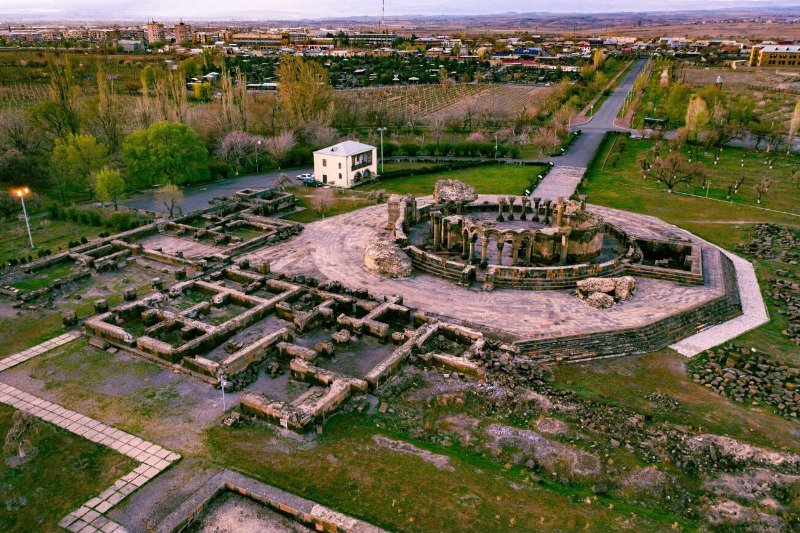
Built in the 7th century, Zvartnots Cathedral incorporated architectural elements from the 4th century, blending traditional Armenian designs with unique structural innovations. According to the historian Sebeos, the cathedral was built at the meeting place of King Tiridates III and Gregory the Illuminator. Its distinct circular design and multi-tiered structure made it an architectural marvel, influencing church designs for centuries.
Byzantine Connection
Zvartnots Cathedral gained international attention when Byzantine Emperor Constantine II attended its consecration ceremony. His presence highlighted the political and cultural ties between the Armenian and Byzantine empires at the time.
Meaning Behind the Name
The name “Zvartnots” is derived from the Armenian word “Zvartun,” which originally meant “Angel” in old Armenian. This name is tied to the legend of Gregory the Illuminator, who had a vision of angels descending at the site, leading to the cathedral’s construction.
Archaeological Discoveries and Research
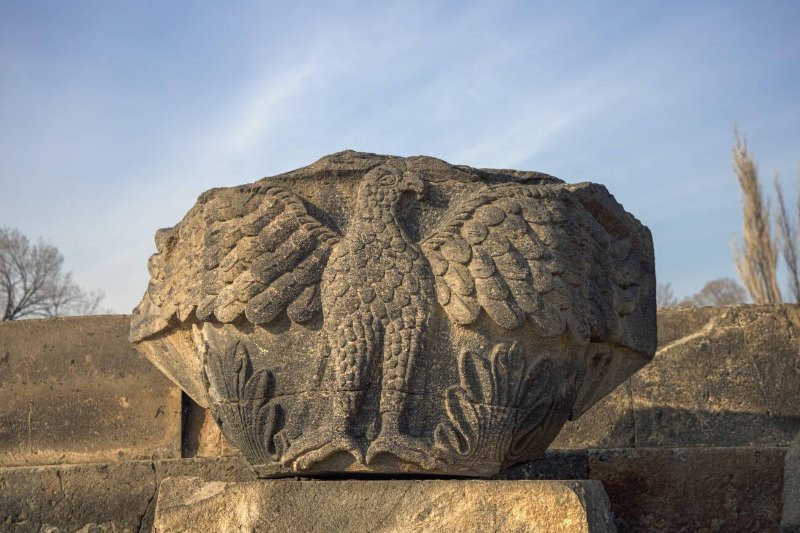
The well-known architect Toros Toramanian uncovered the ruins of Zvartnots Cathedral in the early 20th century. His findings provided invaluable insight into its design and construction techniques. Initially, scholars doubted his descriptions due to the cathedral’s unconventional circular shape. However, evidence from a miniature church held by a statue of King Gagik I of Ani confirmed the accuracy of Toramanian’s research.
Lasting Architectural Influence of Zvartnots Cathedral
The cathedral’s influence goes beyond Armenia, inspiring structures like the 7th-century Banak and Ishkhan churches in Western Armenia and Gagkashen Church in Ani (11th century). Additionally, Lyakit Church in Caucasian Albania (7th century) shares notable design elements with Zvartnots.
A Mysterious Connection to Sainte-Chapelle
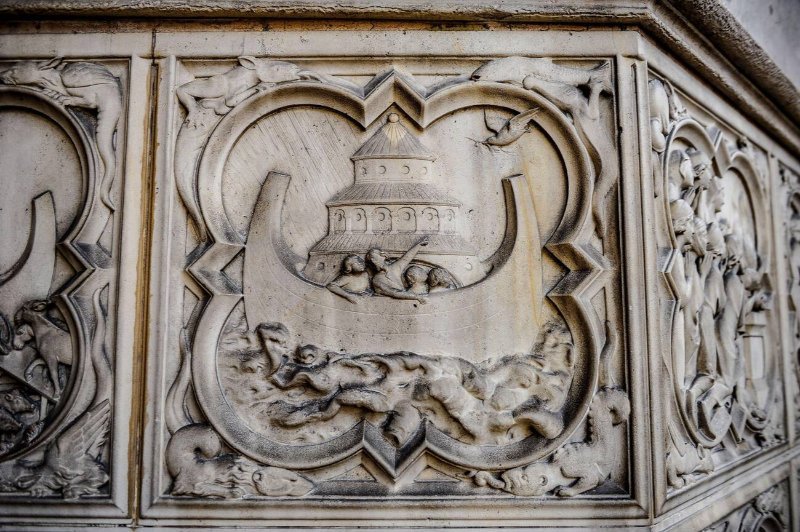
One of the most fascinating aspects of Zvartnots Cathedral is its connection to Sainte-Chapelle in France. Built in the 13th century, Sainte-Chapelle features reliefs depicting Noah’s Ark alongside a structure resembling Zvartnots Cathedral. These artistic representations suggest that the cathedral’s design may have reached Western Europe centuries later. Although some sculptures were damaged during the French Revolution, they were restored in the 19th century, further cementing this historical link.
Debates on Architectural Origins of Zvartnots Cathedral

Historians and architects remain divided on whether Zvartnots Cathedral was solely an Armenian creation or influenced by foreign styles. Some argue that its design reflects elements of Syrian and Byzantine architecture, while others believe it represents a purely Armenian innovation.
One key argument against foreign influence is that similar structures in Syria and Byzantium were built with wood, while Zvartnots was constructed entirely from stone. Despite seismic risks, Armenian architects took the bold step of building a massive stone structure in an earthquake-prone region.
Was There a Pre-existing Temple?
Archaeologist Karo Ghafadaryan suggests that the Zvartnots site had been inhabited long before the 7th century. Evidence points to a pre-existing pagan temple dedicated to Tir, which was later replaced by the cathedral. Excavations have also revealed anchors and artifacts unrelated to the main structure, supporting theories of an earlier religious complex.
Best Time to Visit Zvartnots Cathedral
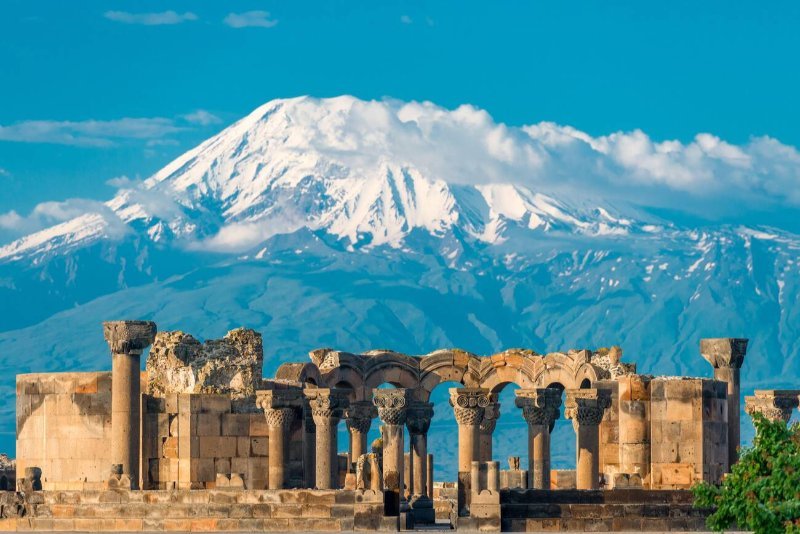
The best time to visit Zvartnots Cathedral is during spring (April to June) and autumn (September to October). These seasons offer pleasant weather, making exploration comfortable and enjoyable. During spring, the surrounding landscapes bloom with lush greenery, providing breathtaking photo opportunities. Autumn, on the other hand, offers mild temperatures and stunning golden foliage, enriching the site’s historic charm. Visiting during these months also means fewer crowds, enabling a deeper and more engaging experience. Since Zvartnots is an open-air site, avoiding the peak summer heat or winter chill ensures a more comfortable visit.
Other Attractions Near Zvartnots Cathedral
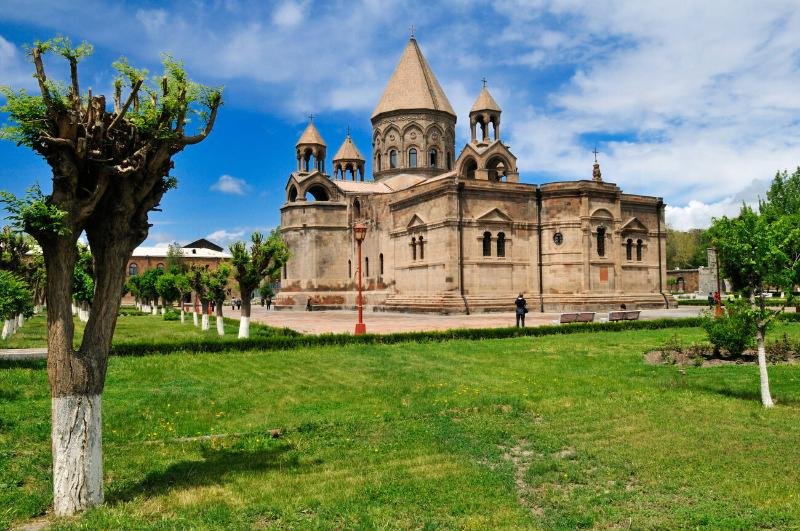
While visiting Zvartnots Cathedral, tourists can explore several other remarkable historical sites nearby. Etchmiadzin Cathedral, located just 3 km away, is one of the world’s oldest Christian churches and a major pilgrimage destination. The Saint Hripsime and Saint Gayane Churches, both UNESCO-listed, showcase Armenia’s rich religious architecture. Additionally, the Sardarapat Memorial, about 20 km from Zvartnots, commemorates Armenia’s victory in the 1918 battle against the Ottoman Empire. Visitors can also explore the Khor Virap Monastery, which offers breathtaking views of Mount Ararat and deep historical significance in Armenian Christianity.
Controversy Over Restoration

Despite various proposals, Zvartnots Cathedral has never been fully restored. Scholars debate whether reconstructing it in its original location would preserve or harm its historical integrity. Some experts argue that reconstruction could generate global interest, similar to the restoration of Hagia Sophia or the Parthenon in Athens. Others fear that rebuilding would erase valuable archaeological evidence.
UNESCO Recognition
In 1989, Zvartnots Cathedral was added to the UNESCO World Heritage List, securing its place as one of Armenia’s most significant cultural landmarks.
Conclusion
Zvartnots Cathedral remains a testament to Armenia’s rich architectural and cultural heritage. Its influence on medieval and European architecture is undeniable. Whether through its Byzantine connections, influence on Western churches, or debates over restoration, the cathedral continues to inspire architects and historians worldwide. As a UNESCO World Heritage Site, Zvartnots Cathedral stands as a symbol of Armenian resilience and artistic mastery.
FAQ
Why is Zvartnots Cathedral famous?
Zvartnots Cathedral in Armenia is famous for its unique circular design, rare stone construction, and influence on medieval architecture across the region and even in Western Europe. Built in the 7th century near Etchmiadzin, it blends Armenian, Byzantine, and possibly Syrian styles, making it a UNESCO World Heritage Site and a must-visit for history and architecture lovers.
What makes Zvartnots Cathedral an architectural wonder
Zvartnots Cathedral is an architectural wonder due to its innovative circular layout and bold stone construction in an earthquake-prone region. Built in the 7th century, it set a precedent for Armenian church design and may have influenced structures like Sainte-Chapelle in France. Its design reflects a fusion of Armenian craftsmanship with broader architectural trends of the era.
When is the best time to visit Zvartnots Cathedral in Armenia
The best time to visit Zvartnots Cathedral is in spring (April–June) or autumn (September–October), when the weather is ideal for exploring. Located near Yerevan and Etchmiadzin, the site offers stunning views and is close to other UNESCO-listed attractions like Etchmiadzin Cathedral and Saint Hripsime Church.





